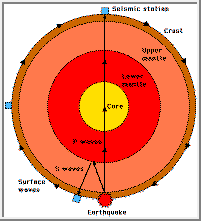|
COMETS EARTH JUPITER KUIPER BELT MARS MERCURY METEORITES NEPTUNE OORT CLOUD PLUTO SATURN SOLAR SYSTEM SPACE SUN URANUS VENUS ORDER PRINTS
PHOTO CATEGORIES SCIENCEVIEWS AMERICAN INDIAN AMPHIBIANS BIRDS BUGS FINE ART FOSSILS THE ISLANDS HISTORICAL PHOTOS MAMMALS OTHER PARKS PLANTS RELIGIOUS REPTILES SCIENCEVIEWS PRINTS
|
Related Document
Download Options
This diagram illustrates the types of seismic waves which travel around the Earth and through the Earth. The speeds of the waves range from 3 to 15 kilometers (1.9 to 9.4 miles) per second. Two of the waves travel around the surface of the Earth in rolling swells. The other two, Primary (P) or compression waves and Secondary (S) or shear waves, penetrate the interior of the Earth. Primary waves compress and dilate the matter they travel through (either rock or liquid) similar to sound waves. They also have the ability to move twice as fast as S waves. Secondary waves propagate through rock but are not able to travel through liquid. Both P and S waves refract or reflect at points where layers of differing physical properties meet. They also reduce speed when moving through hotter material. These changes in direction and velocity are the means of locating discontinuities. This illustration was adapted from: Beatty, J. K. and A. Chaikin, eds. The New Solar System. Massachusetts: Sky Publishing, 3rd Edition, 1990. |
||||||||||||||||||||
